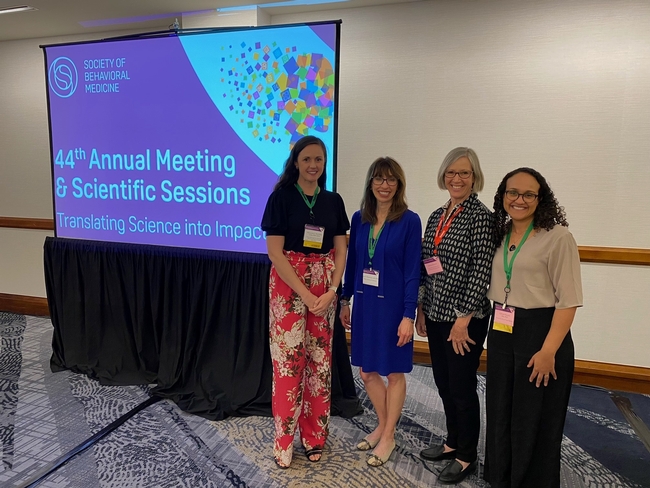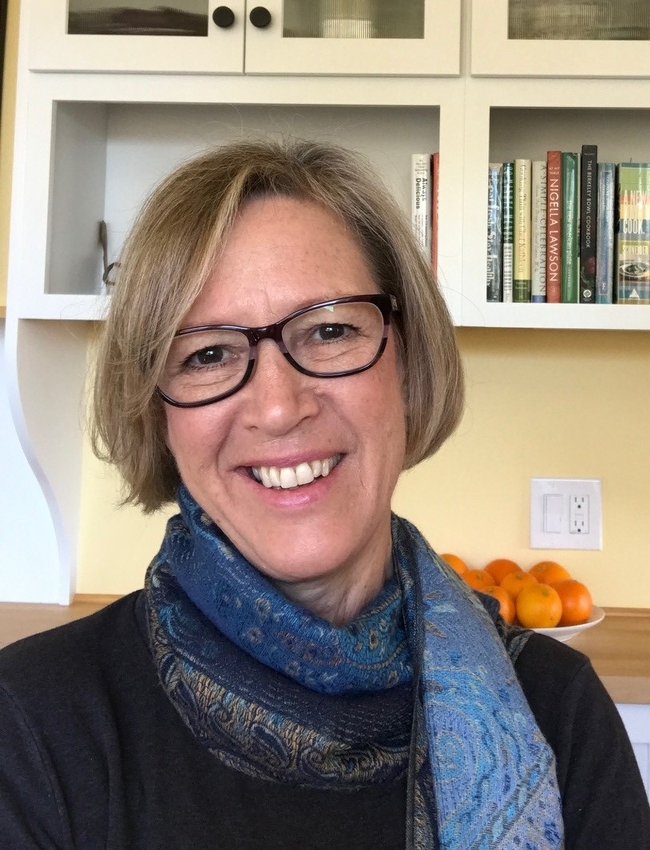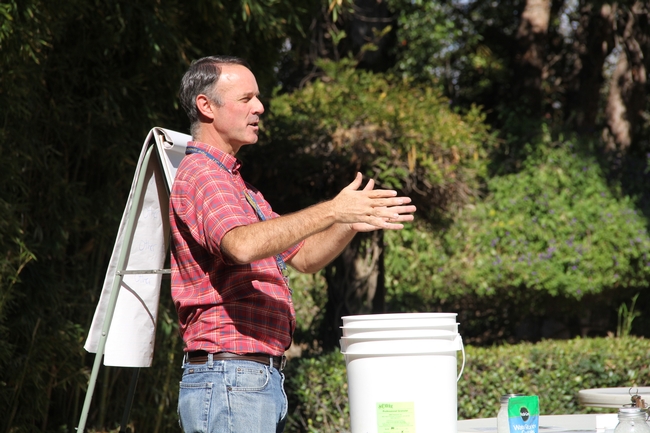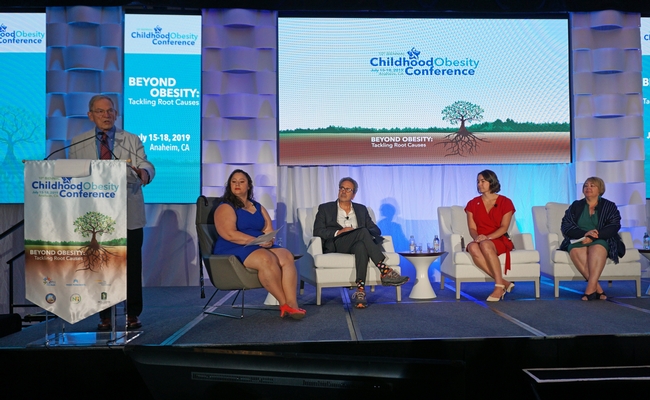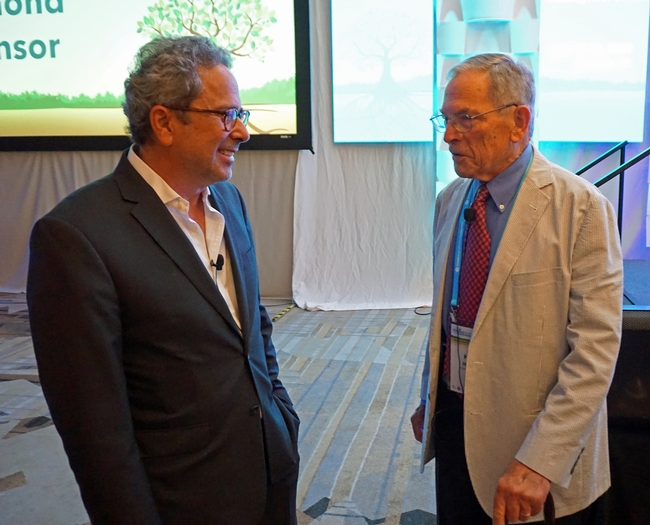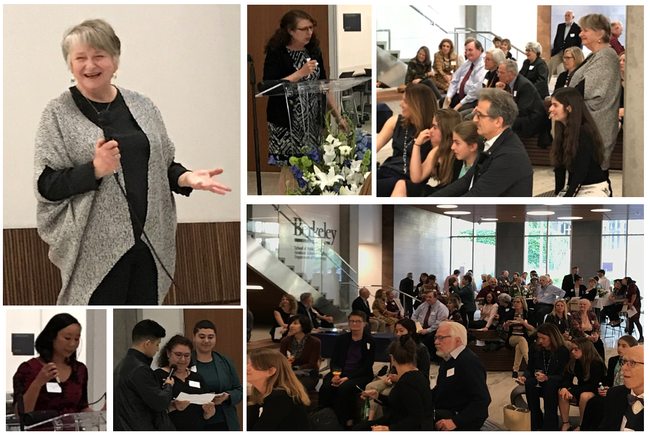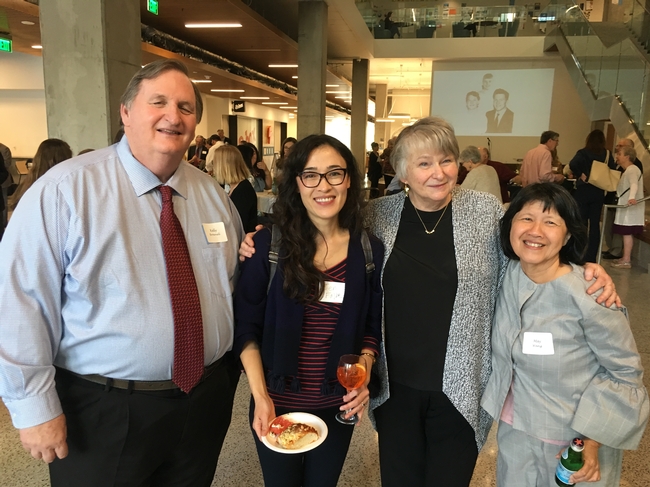Posts Tagged: sugar
Rauzon, visionary in community health evaluation, retires from NPI
Nutrition Policy Institute researcher developed techniques that help identify effective public health programs
When Suzanne Rauzon and May Wang were in the master's of public health program at the University of California, Berkeley during the mid-1980s, Wang knew that her classmate had unique brilliance to bring to their field.
“You know how you vote for the person in high school who's most likely to succeed? That was Suzanne,” said May Wang, a professor of community health sciences in the UCLA Fielding School of Public Health. “Suzanne was always ahead of every one of us; she was so visionary and forward-thinking and I think we were all – to be honest – a little bit in awe of her.”
Decades later, as Rauzon prepares to retire in January 2024 as director of community health at the Nutrition Policy Institute, she has fulfilled that exceptional promise. Her many contributions are helping communities identify the most effective programs to benefit public health.
Lorrene Ritchie, director of NPI (an institute under UC Agriculture and Natural Resources), said that Rauzon has played a pivotal role in translating research findings into community action and policy change. She added that Rauzon has brought an extraordinary combination of strategic vision for the overall direction of nutrition studies and tactical savvy to anticipate the needs of project funders and communities.
“Few people can bring both of those skills – efficiently complete the day-to-day tasks as well as be a big-picture thinker,” Ritchie said. “She has been so instrumental in contributing to NPI's impacts.”
A unique skill set to tackle complex challenges
Part of what makes Rauzon unique in her field is her extensive experience in the private sector. After attaining her master's degree, Rauzon developed a comprehensive employee worksite wellness initiative at a telecommunications company – a new set of programs that led the field in the 1990s.
“Suzanne was, is and has always been very visionary,” Wang said.
After years in the corporate space, however, Rauzon leaped at the chance to return to academia (and reunite with Wang) in 2001 at UC Berkeley's Center for Weight and Health, a precursor to NPI. Working with center co-director Patricia Crawford, Rauzon said the project to investigate the effects of sugar-sweetened beverages was a “perfect fit” for her.
Concerned with rising childhood obesity, the researchers studied the significant differences in health outcomes for students in high schools that limited access to beverages such as soft drinks, versus schools that did not.
“That field in general – looking to limit sugar-sweetened beverages – started with a focus in schools, and expanded into other environments (such as college campuses) over the years, and has continued to be a focus in public health,” Rauzon said, “all the way up to work now on limiting sugar-sweetened beverages access in other public institutions.”
Rauzon's change-management and communication skills also were crucial in studying the revolutionary School Lunch Initiative in the Berkeley Unified School District – a collaboration with chef Alice Waters' Chez Panisse Foundation and the Center for Ecoliteracy to engage young people in the growing and preparation of food. Brought in to evaluate the efficacy of the program, Wang and Rauzon found they had to alter their mindset and methods when working with partners who were responding to oft-changing circumstances.
Rauzon's cross-sector perspective, practical know-how and people skills in cultivating positive relationships with district staff and educators were instrumental in successfully completing studies with as much rigor as possible in real-world settings such as schools.
The researchers created new analytical tools to evaluate health interventions developed by communities themselves – as opposed to programs engineered by academics and applied to community members with the expectation that they would accept it.
“Most researchers, to be honest, are still striving to do that with communities,” Wang said. “It is an incredibly challenging task because communities will do what they want to do – and what they need to do – to respond to the needs of people.”
Wang, who now trains academics in community-based participatory research, said that the ground-up paradigm has been shaped by Rauzon's thinking. “A lot of the ideas I have today really came about from our work together on the School Lunch Initiative,” Wang said.
A legacy of new methods, mentoring early-career professionals
One of Rauzon's longest-running – and most complex – projects has been the evaluation of community health interventions across the country, including a variety of Kaiser Permanente initiatives to promote healthy eating and physical activity.
“What was interesting about that work was we really were trying to understand the combined effects of doing a lot of different things that are related – and to see the overall effect that can have on the community,” said Rauzon, noting that interventions ranged from nutrition classes to policy changes to park and bike-safety improvements.
Wang said some of their findings, particularly from one study in Los Angeles County, suggest that effective programs are early childhood interventions (including an emphasis on breastfeeding), home visitations by nurses and social workers to vulnerable households, and partnerships with retailers to make healthy food choices more accessible.
In the process, the researchers helped pioneer new research tools – including interdisciplinary “systems mapping” approaches in which computer scientists discern linkages among various programs and their effects, and the highly influential “community intervention dose index” concept that can be used to evaluate multiple intervention strategies within a community.
In addition to Rauzon's contributions in research and evaluation, Ritchie also highlighted her role in supervising and mentoring students and NPI staff and researchers during her 20-plus years with the UC – the role in which Rauzon takes the most pride.
“While I made a contribution to community health in effective interventions and how to measure them,” Rauzon said, “I would say personally the most rewarding part of the work I've done over the last couple of decades is seeing the growth and development and advancement of people who have worked for me and who have really taken off in their own careers – that to me has been immensely satisfying.”
As an emeritus researcher, Rauzon will continue to support NPI professionals and their research, and she added that she's excited to embark on a new partnership – with her husband, a geographer – to mitigate impacts of climate change on human and environmental health across the globe.
People interested in supporting Rauzon's legacy and the ongoing work in health and nutrition can donate to NPI's Student Fellowship, which provides students from underrepresented groups the opportunity to work on NPI research and be mentored by NPI researchers.
UCCE researchers target sugar-feeding ants, a key to controlling citrus pests, disease
Sugar-feeding ants protect pests that infect trees and damage the fruit they bear. Insecticides are often a go-to solution, but may kill beneficial insects in the process, too. Thankfully, Mark Hoddle, University of California Cooperative Extension entomologist and biological control specialist at UC Riverside, together with UCR colleagues in chemical engineering, developed a biodegradable hydrogel baiting system that targets ant populations, which protect sap-sucking pests from their natural enemies. Control of ants allows beneficial parasitoids and predators to greatly reduce pest populations.
Deciding to expand Hoddle's research was a “no-brainer” according to David Haviland, UC Cooperative Extension farm advisor in Kern County.
Haviland is investigating active ingredients that can be effectively used in hydrogel baiting systems. His research builds on Hoddle's use of alginate gels, also known as water beads, soaked in sugar water to control Argentine ants.
“What we're doing in California can benefit places like Florida, Texas, Mexico and beyond,” Haviland said.
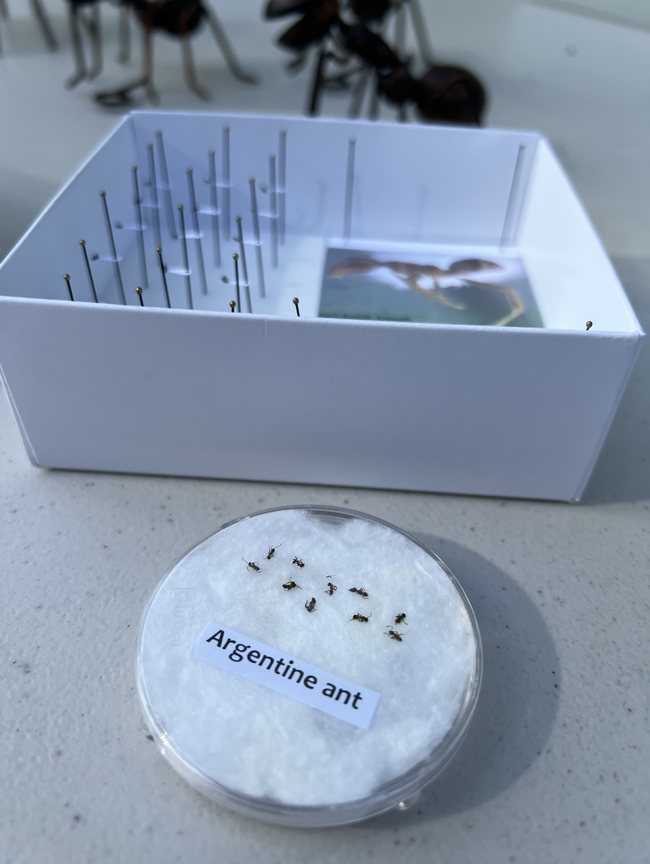
The Hoddle lab conducted two years of orchard research showing that when ants are controlled, the amount of citrus flush infested with Asian citrus psyllid (ACP), a mottled brown insect that vectors the pathogen causing citrus greening, decreases by 75%. Citrus flush refers to newly developed leaves.
“But benefits are not restricted to just ACP with Argentine ant control, as natural enemies destroy colonies of other sap-sucking pests too,” said Hoddle. “For example, citrus mealybug infestations on leaves were completely eliminated by natural enemies, 100% control, while densities of fruit infested by mealybugs were reduced by 50%.”
The Hoddle lab's success inspired Haviland to consider how this approach will fare in different regions of the state where there are different crops, different pests and different ant species.
Haviland has worked for many years on solid baits that are effective and affordable for ants that feed primarily on protein, like fire ants in almonds, but successful control measures for sugar-feeding ants that drink their food have been elusive.
“Therefore, we're using hydrogels to essentially turn a liquid bait into a solid, making it effective and commercially adoptable,” Haviland said. He and his team are assessing whether active ingredients that undoubtedly work against ants, like thiamethoxam, maintain their effects in a hydrogel system.
Unlike Hoddle's biodegradable alginate gels, Haviland is relying on acrylamide gels that are similar to the absorbing material you would find in a diaper. These gels are not organic, but are currently accessible on a commercial scale, and have been shown to be effective in wine grapes on the North Coast by a Cooperative Extension advisor in Napa County, Monica Cooper. Haviland's current research efforts are focused on citrus, table grapes and wine grapes in the San Joaquin Valley, and on lemons on the coast.
The primary challenge now is navigating pesticide regulations and registration.
“This is cutting-edge research,” Haviland said, and manufacturer labels for the products being used need to be updated to include hydrogels as an approved use. This process takes time. Additionally, adding new product uses needs to make economic sense for the manufacturer.
Hoddle and Haviland's research can provide data for adding these methods to the product labels.
“If we can show that this tech works against lots of pests, lots of ant species, in lots of different crops across California, hopefully we'll achieve a critical mass of benefits that motivates product manufacturers to make modifications to their labels,” said Haviland.
Haviland is hopeful about the process, and said he believes that UC ANR is in a prime position to lead innovation for an issue that requires collaboration among specialists, advisors and the industry.
New policies can inspire families to provide healthy beverages to children
At fast food and sit-down restaurants across California, kids' meals come with water or milk automatically. At least, that should be the case since state law requires restaurants to offer the healthy beverages by default to reduce the amount of sugary beverages served to children.
California Senate Bill 1192, authored by Sen. Bill Monning (D-San Luis Obispo), went into effect Jan. 6, 2019, but research by the UC Nutrition Policy Institute (NPI) has found that implementation has not been universal and more can be done. The results, along with results from a similar study in Wilmington, Del., were published Aug. 20 on HealthyEatingResearch.org.
Before the law, 10% of menu boards observed by the researchers in California listed only the healthy beverages. Data collected after the law went into effect showed 66% of menu boards list the healthy default beverages. The researchers also collected data on the proportion of cashiers who verbally offered only healthy beverages with kids' meals when orders were placed. This happened only 5% of the time before the law was enacted, and dropped to 1% after.
“Parents look at menu boards and kids look at menu boards, but it is likely that what the cashier says also influences which drink they choose,” said Lorrene Ritchie, NPI director and UC Cooperative Extension nutrition specialist. Ritchie was the lead researcher on the California portion of the study. “In our data collection, we would order a kids' meal and wait for them to offer a drink. But mostly they said, ‘What drink do you want?' instead of ‘Do you want water or milk with that?'”
The law doesn't specify whether the cashier must offer the default beverages, but the spirit of the law suggests they should, as it would likely have a greater impact on the selections that children and parents make, Ritchie said.
According to Gail Woodward-Lopez, an NPI researcher and co-investigator on the study, most restaurant managers expressed support for the legislation, but didn't know much about it.
“NPI in partnership with the California Department of Public Health is working with some local health departments to provide training and materials to help restaurants comply with the letter and spirit of the law,” Woodward-Lopez said. “Our next step is to measure whether this health department support is effective.”
The dire need to direct children away from sugary sodas is clear. Empty calories from soda and other sugar-sweetened beverages is the No. 1 cause of obesity in children, Ritchie said. Obese children are at least twice as likely as non-obese children to become obese adults. Obese children and adults are at greater risk for Type 2 diabetes, heart disease, stroke, high blood pressure, high cholesterol, certain cancers, asthma, low self-esteem, depression and other diseases. The Centers for Disease Control and Prevention names obesity as one of the conditions that increase risk of severe illness from COVID-19.
Many open questions remain, such as how drinks are portrayed on drive-thru signs and offered by drive-thru order takers. The COVID-19 pandemic has also altered the way Americans purchase food, with increased online ordering, delivery and drive-thru usage. In-store kiosk ordering is also growing in popularity.
“The role of default beverage policies in this context is important and not well understood,” Woodward-Lopez said.
Woodward-Lopez and Ritchie are working with colleagues around California and across the country to design follow-up studies of newer food technologies and beverage policies being passed elsewhere, to determine how government policies can protect children's health by steering them toward healthy beverage consumption.
The newly published research was funded by the Robert Wood Johnson Foundation and by the California Department of Public Health with funding from the United States Department of Agriculture.
Soda tax advocates ride a political roller-coaster
When Genoveva Islas was 12 years old, she was responsible for giving insulin injections to her diabetic tia, her aunt.
“Tia lost her toes, lost her leg, lost her life,” Islas said. “This is a very important fight.”
Islas is director of Cultiva La Salud in Fresno, which works to address poor nutrition and physical inactivity in the San Joaquin Valley. The fight Islas referred to is the “soda wars,” a battle to reduce the amount of sugar-sweetened beverages (SSBs) consumed by Americans. SSBs are the single most significant source of sugar in Americans' diets, amounting to nearly half of sugar intake. They have been unequivocally linked to increases in obesity, diabetes, heart disease, liver disease, tooth decay and some cancers.
Islas talked about the tragic fate of her tia at the July 2019 California Obesity Conference in Anaheim, where 1,025 public health, nutrition, science and political leaders convened to share strategies for overcoming the childhood obesity crisis in the United States. She was part of a panel on taxing sugary drinks to reduce SSB consumption and fund community health programs.
“I'm here because I believe health is a right, not a luxury,” Islas said. “A soda tax is a fight for the community I love.”

“I say regressive is the incidence of diabetes in my community, the incidence of heart disease in my community,” Islas said. “The California Central Valley has the highest rates of drinking water violations. Bottled water is costly. People are choosing sugar-sweetened beverages when it is the most affordable choice for them.”
Money raised by the soda tax, Islas continued, could support water quality improvements and encourage the public to drink free and safe tap water.
California Assemblymember Richard Bloom (D-Santa Monica), who has proposed soda tax legislation several times, was also on the soda tax panel.
“The soda industry has poured a huge amount of money toward lobbying in Sacramento against soda restriction laws,” he said.
Bloom suggested that soda tax proponents be clear about the implications of childhood obesity and associated diseases when working to implement soda tax laws.
“Words like ‘epidemic' and ‘crisis' are used so much, they start to lose their meaning,” Bloom said. “We have a lot of statistics on the science of sugary drinks, but we don't talk about the misery this visits upon people and families and communities – amputations, heart disease, cancer. We need to start telling those stories viscerally.”
Kenneth Hecht, director of policy at UC's Nutrition Policy Institute, moderated the panel discussion. He said that a soda tax is the most cost-effective intervention to reduce soda consumption. It has been implemented and studied in Berkeley, Calif., where voters in 2014 passed a local initiative to tax soda and other sugar-sweetened beverages 2 cents per ounce. Three years later, residents reported drinking 52 percent fewer servings of sugary drinks than they did before the tax was imposed.
“Soda taxes work,” said Kristine Madsen, director of the Berkeley Food Institute and professor at UC Berkeley School of Public Health, who evaluated the Berkeley soda tax and also spoke at the conference.
The bulk of Berkeley's soda tax revenue is dedicated to supporting nutrition education and gardening programs in schools and allocated to local organizations working to encourage healthier behaviors in Berkeley.
San Francisco, Oakland and Albany also passed soda taxes. Other communities were planning to put soda tax initiatives on the ballot, but were stymied by a preemptive strike waged by the soda industry. In June 2018, the California Legislature passed a bill to preempt any new local beverage or food taxes until 2031. According to Assemblymember Bloom, beverage companies spent millions to get an initiative on the ballot that would have prevented local communities from raising taxes without a two-thirds vote, up from 55% of the vote currently needed. They offered to drop the initiative if the California Legislature would impose a moratorium on local soda taxes.
Bloom called the preemption a “disgusting tactic.”
“We had to capitulate to that to protect our local governments,” Bloom said. “It was never a sprint to address soda tax, but now it's become a marathon.”
Public health activists were also outraged.
“If you have enough money, you can put anything on the ballot and use that to extort lawmakers to get what you want,” said Mark Pertschuk, director of Grassroots Change and a conference speaker. “This is a war on local democracy. We need to educate people on what preemption is.”

“It's the same as being tobacco free and drug free,” he said.
One public organization leading the way is UC San Francisco (UCSF), which employs 22,000 staff, academics and medical professionals. In 2015, all its campuses and buildings removed sugar-sweetened beverages from food service outlets and vending machines as part of its Healthy Beverage Initiative. Laura Schmidt, professor in the Institute for Health Policy Studies at UCSF, discussed the ban at the Childhood Obesity Conference.
“When you live in a saturated environment, where it's always in reach, that makes it difficult to say no,” Schmidt said. “We have to change the environment. All effective solutions follow the iron law of public health. If you reduce availability of harmful substances in the environment, you will reduce consumption.”
At the culmination of his Childhood Obesity Conference talk, Bloom announced the recent formation of Californians for Less Soda, a new coalition of public health and health equity advocates and health professionals aligned to decrease consumption of sugar-sweetened beverages in California through effective policies.
Catalyst of change Pat Crawford’s research helps advance food policies
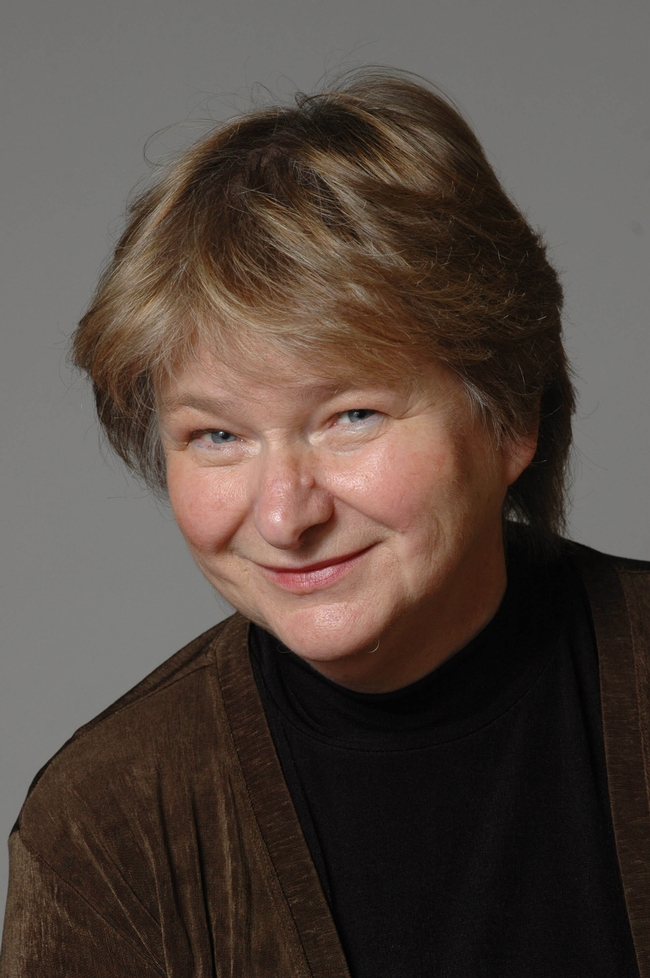
The San Francisco Chronicle reported this exercise in a 2016 interview with Crawford about newly approved USDA nutrition labels that would include added sugar information and thereby eliminate the need for such complex computations by consumers. Sadly, these nutrition guidelines have yet to come out. Why not, if we know that added sugar is related to heart disease, diabetes, tooth decay and other negative health conditions? Why hasn't this regulation been adopted? Crawford works to provide the research needed by policymakers to reduce the barriers to implementation of helpful policies such as this one.
Pat Crawford's work on improved food labeling is but one example of the way that for decades her timely and rigorous research has demonstrated the role of sugary foods and beverages in the development of diabetes, and obesity and in helping to fuel America's childhood obesity epidemic. In countless ways Crawford, who is retiring this year after more than 40 years of service at the University of California, has supported the adoption of public policies that promote safer, healthier food and beverages for all people, across the state and the nation.
You can draw direct lines from her resume to countless major policy advances in nutrition education and public health. Since earning her master's degree in public health nutrition and her registered dietician credential at UC Berkeley in 1972, Crawford has been a force of unceasing productivity as a researcher, an evaluator, an educator and a leader. Early in her career she managed the nation's largest biracial study of girls' health, the National Growth and Health Study. During the course of this long-term study, she went back to school to obtain her doctorate in public health nutrition. She soon was hired as the first UC Cooperative Extension Nutrition and Obesity Prevention specialist and she co-founded and directed UC Berkeley's Atkins Center for Weight and Health. The work of the center focused largely on food and nutrition policy to improve the health of children, and it provided a structure whereby University research could be effectively shared with community health workers throughout the state. Local and state health professionals found in the center an extension partner eager to conduct research that would answer important questions and provide real-world solutions, productively linking research, policy and practice.
The Center for Weight and Health, which in 2015 merged with the UC ANR Nutrition Policy Institute (NPI), became known for rigorous research that is aligned with UC ANR's core values of addressing food security, obesity, socioeconomically based health disparities, and access to healthy foods. After the merger, Crawford became NPI's Senior Director of Research, working with her long time collaborator, Lorrene Ritchie, the NPI director.
Ritchie stated that in addition to Crawford's academic achievements, she is the consummate mentor — a “career godmother” for Ritchie and many others. She said, “Pat has an uncanny ability of knowing what you are good at — even before you yourself do — and mentoring you to build on that strength. Likewise, she has an uncanny ability to know your weaknesses, and help you to overcome those by developing new skills or pairing you with others who have those skills.”
That kind of nurturing is rare, Ritchie noted, particularly in the competitive environment of academia. Through mentoring, she added, Crawford has ensured new generations of researchers will continue this work.
“Pat has proven that you can be caring and compassionate yet still be highly effective.”
Catalyzing change
What does highly effective look like? A few examples illustrate the impact that Pat Crawford's work has had on nutrition policies and trends.
To improve the food environment at child care centers and schools, the Center/NPI provided the evidence for:
- California's 2010 Healthy Beverages in Childcare Law, requiring child care centers to make water and other healthy beverages available at all times.
- The 2013 Foundations for Healthy Nutrition in Childcare Act, requiring nutrition education for all child care providers.
- “Competitive food” policies — banning unhealthy sodas and snacks that competed with more nutritious school lunches — a policy that started in California and later was implemented at the federal level in the USDA's 2016 “Smart Snacks Standards.”
- The expansion of school garden and cooking programs in California and nationwide.
- An expansion of support for replacing packaged foods with healthier scratch cooking in school cafeterias.
To promote more nutritious food in programs serving low-income families the Center/NPI advocated:
- Improvements in the federal Women, Infants and Children (WIC) program including quadrupling the amount of vegetables and legumes WIC provides and adding information about physical activity needs for young children.
- Food bank policies that increase the amount of fruits and vegetables distributed and reduce the amount of snack foods and sugary beverages. Their free online course on how to make these policy shifts is a popular web resource for food banks across the country.
To advance education and communication:
- Crawford co-founded the first interdisciplinary conference on childhood obesity. Twenty years later, the biennial meeting is the premier obesity conference in the nation.
- The “My Healthy Plate” nutrition-education tool, which replaced the old Healthy Eating Pyramid, was developed, tested, presented and promoted by Crawford and her extension colleagues before the plate concept was officially adopted by USDA in 2011.
- California became the first state to put calories on chain-restaurant menus. Crawford's evaluation of Kaiser Permanente's pilot study of menu-board labeling provided the evidence needed by policymakers. Calorie labeling in chain restaurants has been expanded nationwide.
- Crawford's evaluation of California's SNAP-Ed program, the education arm of the Supplemental Nutrition Assistance Program, (or SNAP, previously known as food stamps), has informed programming focused on the prevention of chronic disease through efficacious nutrition changes in the environment.
Although Crawford would be quick to tell you that her work is collaborative, she has been a researcher or important influence on nearly every population-based nutrition policy success. She has served as president of the California Nutrition Council and on countless state and national committees and task forces focused on improving health and addressing obesity, including being an advisor to California's Let's Get Healthy Task Force. Most recently, she co-authored a seminal Healthy People 2020 report for the U.S. Department of Health and Human Services, Office of Disease Prevention and Health Promotion, on model policies to increase fruit and vegetable intake in the population.
Training the next generation
Given her commitment and her influence, it's no wonder that Pat Crawford won the 2013 David Kessler Award for Extraordinary Contributions to the Public's Health, as well as multiple honors from the American Public Health Association. In 2018, the UC Berkeley School of Public Health honored Crawford as one of its 75 most influential alumni in recognition of her significant contributions to reduce the epidemic of childhood obesity in California and across the country. And she's not done yet — as an emeritus Cooperative Extension specialist, her research will go on. That won't surprise anyone who knows her. As Crawford said in a 2015 interview, “What keeps me passionate is knowing that change is possible when high-quality, policy-relevant research is conducted and communicated to decision-makers and those who work with children.”
To honor the work that Crawford does and to continue this kind of work, the Nutrition Policy Institute has established a student fellowship fund to train the next generation of students on nutrition research and its policy impacts. Donors to the student fellowship fund help honor Crawford and help NPI continue its work to improve the nutrition and health of children.
